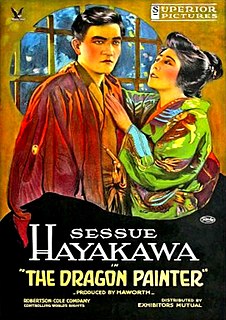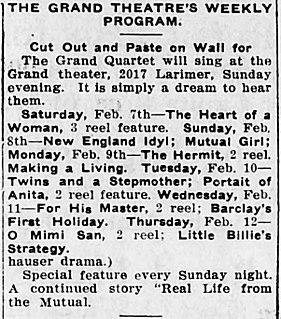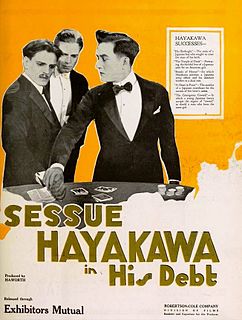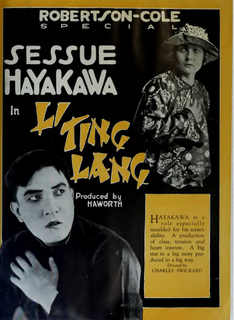
Kintarō Hayakawa, known professionally as Sessue Hayakawa, was a Japanese actor and a matinée idol. He was one of the most popular stars in Hollywood during the silent film era of the 1910s and early 1920s. Hayakawa was the first actor of Asian descent to achieve stardom as a leading man in the United States and Europe. His "broodingly handsome" good looks and typecasting as a sexually dominant villain made him a heartthrob among American women during a time of racial discrimination, and he became one of the first male sex symbols of Hollywood.

The Dragon Painter is a 1919 English language silent romance drama film. It is based on the novel of the same name, written by Mary McNeil Fenollosa. It stars Sessue Hayakawa as a young painter who believes that his fiancée, is a princess who has been captured and turned into a dragon. It was directed by William Worthington and filmed in Yosemite Valley, Yosemite National Park, and in the Japanese Tea Garden in Coronado, California.

O Mimi San is a 1914 American short silent drama film directed by Charles Miller, featuring Tsuru Aoki in the title role and Sessue Hayakawa, Kisaburo Kurihara, Chick Morrison and George Osborne in pivotal roles. It was preserved in 1995.
A Tragedy of the Orient is a 1914 American silent short drama film directed by Reginald Barker and featuring Sessue Hayakawa, Tsuru Aoki, Frank Borgaze and George Osborne in important roles.
A Relic of Old Japan is a 1914 American silent short drama film directed by Reginald Barker and Thomas H. Ince. Sessue Hayakawa, Tsuru Aoki, Frank Borzage and Henry Kotani played important roles in the film.

The Courageous Coward is a 1919 American silent drama film directed by William Worthington and featuring Sessue Hayakawa and Tsuru Aoki in lead roles. It is presumed to be a lost film, with only reel 5 preserved at the EYE Film Institute Netherlands film archive.
Star of the North is a 1914 American silent short adventure film directed by Thomas H. Ince and Jay Hunt. Sessue Hayakawa, Tsuru Aoki, J. Frank Burke, Herschel Mayall and Ernest Swallow played important roles in the film.
The Curse of Caste is a 1914 short drama film directed by Reginald Barker and featuring Sessue Hayakawa, Tsuru Aoki and Thomas Kurihara in important roles.

The Death Mask is a 1914 American short drama film directed and produced by Thomas H. Ince and featuring Sessue Hayakawa and Tsuru Aoki in prominent roles.
The Vigil is a 1914 American short silent drama film directed by George Osborne and featuring Tsuru Aoki, Sessue Hayakawa, Thomas Kurihara and Mr. Yamato in prominent roles.
The Last of the Line is a 1914 American short silent Western film directed by Jay Hunt and featuring Joe Goodboy, Sessue Hayakawa, Tsuru Aoki, Stanley Bigham and Gladys Brockwell in pivotal roles.

His Birthright is a 1918 American drama film directed by William Worthington for Haworth Pictures Corporation. Sessue Hayakawa produced the film and played the lead role. The rest of the cast includes Marin Sais, Howard Davies, Mary Anderson, and Hayakawa's wife Tsuru Aoki.

A Heart in Pawn is a 1919 American silent drama film directed by William Worthington. Sessue Hayakawa's Haworth Pictures Corporation produced the film and Worthington played the lead role along with Vola Vale and his wife Tsuru Aoki.

The Gray Horizon is a 1919 American silent drama film directed by William Worthington. Sessue Hayakawa's Haworth Pictures Corporation produced the film and he himself played the lead role. Bertram Grassby, Tsuru Aoki, Eileen Percy, Mary Jane Irving, and Andrew Robson also featured in the film.

Bonds of Honor is a 1919 American silent film directed by William Worthington. Sessue Hayakawa's Haworth Pictures Corporation produced the film and he himself played the leading roles along with his wife Tsuru Aoki. Marin Sais, Dagmar Godowsky, Herschel Mayall, Toyo Fujita and M. Foshida also appeared in the film.
Banzai is a 1918 American short film starring Sessue Hayakawa and produced by his Haworth Pictures Corporation.

His Debt is a 1919 American silent drama film directed by William Worthington and produced by Haworth Pictures Corporation.
Daisuke Miyao is a professor of Japanese films at the University of Oregon and the University of California San Diego. He is also the author of Sessue Hayakawa: Silent Cinema and Transnational Stardom and The Aesthetics of Shadow: Lighting and Japanese Cinema, editor of Oxford Handbook of Japanese Cinema and co-translator of Ozu's Anti-Cinema.

The Beggar Prince is a lost 1920 film directed by William Worthington and produced by Sessue Hayakawa's Haworth Pictures Corporation.

Li Ting Lang is a 1920 American silent drama film directed by Charles Swickard and produced by Sessue Hayakawa's Haworth Pictures Corporation.













